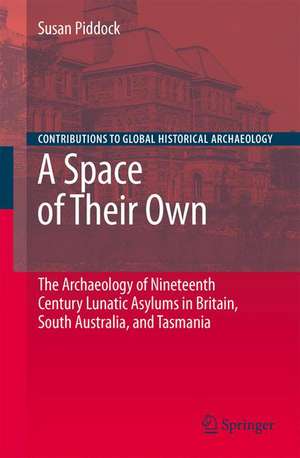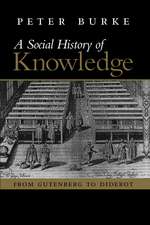A Space of Their Own: The Archaeology of Nineteenth Century Lunatic Asylums in Britain, South Australia and Tasmania: Contributions To Global Historical Archaeology
Autor Susan Piddocken Limba Engleză Hardback – 27 sep 2007
| Toate formatele și edițiile | Preț | Express |
|---|---|---|
| Paperback (1) | 1093.35 lei 43-57 zile | |
| Springer – 16 mar 2019 | 1093.35 lei 43-57 zile | |
| Hardback (1) | 1100.30 lei 43-57 zile | |
| Springer – 27 sep 2007 | 1100.30 lei 43-57 zile |
Din seria Contributions To Global Historical Archaeology
- 15%
 Preț: 640.24 lei
Preț: 640.24 lei - 15%
 Preț: 642.36 lei
Preț: 642.36 lei - 15%
 Preț: 643.84 lei
Preț: 643.84 lei -
 Preț: 399.12 lei
Preț: 399.12 lei - 15%
 Preț: 639.90 lei
Preț: 639.90 lei - 15%
 Preț: 644.82 lei
Preț: 644.82 lei - 15%
 Preț: 636.80 lei
Preț: 636.80 lei - 15%
 Preț: 643.84 lei
Preț: 643.84 lei - 18%
 Preț: 949.23 lei
Preț: 949.23 lei - 15%
 Preț: 640.24 lei
Preț: 640.24 lei - 15%
 Preț: 640.06 lei
Preț: 640.06 lei - 15%
 Preț: 641.71 lei
Preț: 641.71 lei - 15%
 Preț: 646.75 lei
Preț: 646.75 lei - 15%
 Preț: 642.03 lei
Preț: 642.03 lei -
 Preț: 390.46 lei
Preț: 390.46 lei -
 Preț: 391.79 lei
Preț: 391.79 lei - 15%
 Preț: 642.51 lei
Preț: 642.51 lei - 15%
 Preț: 647.73 lei
Preț: 647.73 lei -
 Preț: 383.71 lei
Preț: 383.71 lei -
 Preț: 387.96 lei
Preț: 387.96 lei - 15%
 Preț: 643.99 lei
Preț: 643.99 lei - 18%
 Preț: 968.65 lei
Preț: 968.65 lei - 15%
 Preț: 639.08 lei
Preț: 639.08 lei - 15%
 Preț: 636.63 lei
Preț: 636.63 lei - 18%
 Preț: 954.93 lei
Preț: 954.93 lei -
 Preț: 384.86 lei
Preț: 384.86 lei - 15%
 Preț: 641.85 lei
Preț: 641.85 lei - 15%
 Preț: 641.53 lei
Preț: 641.53 lei - 15%
 Preț: 643.99 lei
Preț: 643.99 lei - 15%
 Preț: 645.28 lei
Preț: 645.28 lei - 18%
 Preț: 733.46 lei
Preț: 733.46 lei
Preț: 1100.30 lei
Preț vechi: 1158.20 lei
-5% Nou
Puncte Express: 1650
Preț estimativ în valută:
210.55€ • 220.38$ • 175.24£
210.55€ • 220.38$ • 175.24£
Carte tipărită la comandă
Livrare economică 31 martie-14 aprilie
Preluare comenzi: 021 569.72.76
Specificații
ISBN-13: 9780387733852
ISBN-10: 038773385X
Pagini: 265
Ilustrații: XII, 265 p.
Dimensiuni: 155 x 235 x 18 mm
Greutate: 0.57 kg
Ediția:2007
Editura: Springer
Colecția Springer
Seria Contributions To Global Historical Archaeology
Locul publicării:New York, NY, United States
ISBN-10: 038773385X
Pagini: 265
Ilustrații: XII, 265 p.
Dimensiuni: 155 x 235 x 18 mm
Greutate: 0.57 kg
Ediția:2007
Editura: Springer
Colecția Springer
Seria Contributions To Global Historical Archaeology
Locul publicării:New York, NY, United States
Public țintă
ResearchCuprins
A Space of Their Own.- The Archaeology of Institutions.- The Archaeology of Lunatic Asylums.- The Changing Face of Insanity and Rise of the Institution.- Constructing the ‘Ideal’.- The British Lunatic Asylum: Ideals and Realities.- South Australia and the ‘Ideal’ Lunatic Asylum.- Tasmania and the ‘Ideal’ Asylum.- The ‘Ideal’ Asylum: A World of Difference.- Conclusion: Archaeology and Lunatic Asylums.
Textul de pe ultima copertă
A Space of Their Own: The Archaeology of Nineteenth Century Lunatic Asylums in Britain, South Australia, and Tasmania
by Susan Piddock, Department of Archaeology, Flinders University, Adelaide, South Australia
The history of lunatic asylums – what do we really know about them? Films and television programs have portrayed them as places of horror where the patients are restrained and left to listen to the cries of their fellow inmates in despair. But what was the world of nineteenth century lunatic asylums really like? Are these images true? This book will explore this world using the techniques of historical archaeology and history.
In the late eighteenth and early nineteenth centuries the advent of new treatments for insanity based on moral therapy and non-restraint, and an increasing social awareness of the conditions in which the insane were being kept led to a new focus on the provisions made for the insane in " madhouses " , lunatic asylums and hospitals. In response to this new focus those interested in the reform of these places and the new treatment regimes began to describe what lunatic asylums should be if they were going to bring the insane back to sanity. In this book a new methodology is developed using these descriptions as the basis of a series of ‘ideal’ asylum models. A comparison of these ‘ideal’ asylums to the lunatic asylums built in England, South Australia and Tasmania allows us to enter the world of the nineteenth century asylum, and to understand the effects of achieving or failing to achieve the ‘ideal’ asylum on life within these places.
Through the case studies of England, South Australia, and Tasmania, this book seeks to identify the forces at work within each society that led to the particular provisions being made for the insane in each place. It will be argued that the adoption of the ‘ideal’ asylum features can be directly related to anumber of key factors, these were: access to a pool of knowledge about lunatic asylum design; economic constraints; the treatment mode adopted; and social perceptions of who was to be accommodated in the asylum - paupers, the middle class, the higher class, or convicts.
by Susan Piddock, Department of Archaeology, Flinders University, Adelaide, South Australia
The history of lunatic asylums – what do we really know about them? Films and television programs have portrayed them as places of horror where the patients are restrained and left to listen to the cries of their fellow inmates in despair. But what was the world of nineteenth century lunatic asylums really like? Are these images true? This book will explore this world using the techniques of historical archaeology and history.
In the late eighteenth and early nineteenth centuries the advent of new treatments for insanity based on moral therapy and non-restraint, and an increasing social awareness of the conditions in which the insane were being kept led to a new focus on the provisions made for the insane in " madhouses " , lunatic asylums and hospitals. In response to this new focus those interested in the reform of these places and the new treatment regimes began to describe what lunatic asylums should be if they were going to bring the insane back to sanity. In this book a new methodology is developed using these descriptions as the basis of a series of ‘ideal’ asylum models. A comparison of these ‘ideal’ asylums to the lunatic asylums built in England, South Australia and Tasmania allows us to enter the world of the nineteenth century asylum, and to understand the effects of achieving or failing to achieve the ‘ideal’ asylum on life within these places.
Through the case studies of England, South Australia, and Tasmania, this book seeks to identify the forces at work within each society that led to the particular provisions being made for the insane in each place. It will be argued that the adoption of the ‘ideal’ asylum features can be directly related to anumber of key factors, these were: access to a pool of knowledge about lunatic asylum design; economic constraints; the treatment mode adopted; and social perceptions of who was to be accommodated in the asylum - paupers, the middle class, the higher class, or convicts.
Caracteristici
The first volume to examine institutional archaeology on a global level Demonstrates that institutions (and the buildings/rooms that are included within) can give a unique insight into society at a given period of time The author is in the forefront of this new field in historical archaeology










